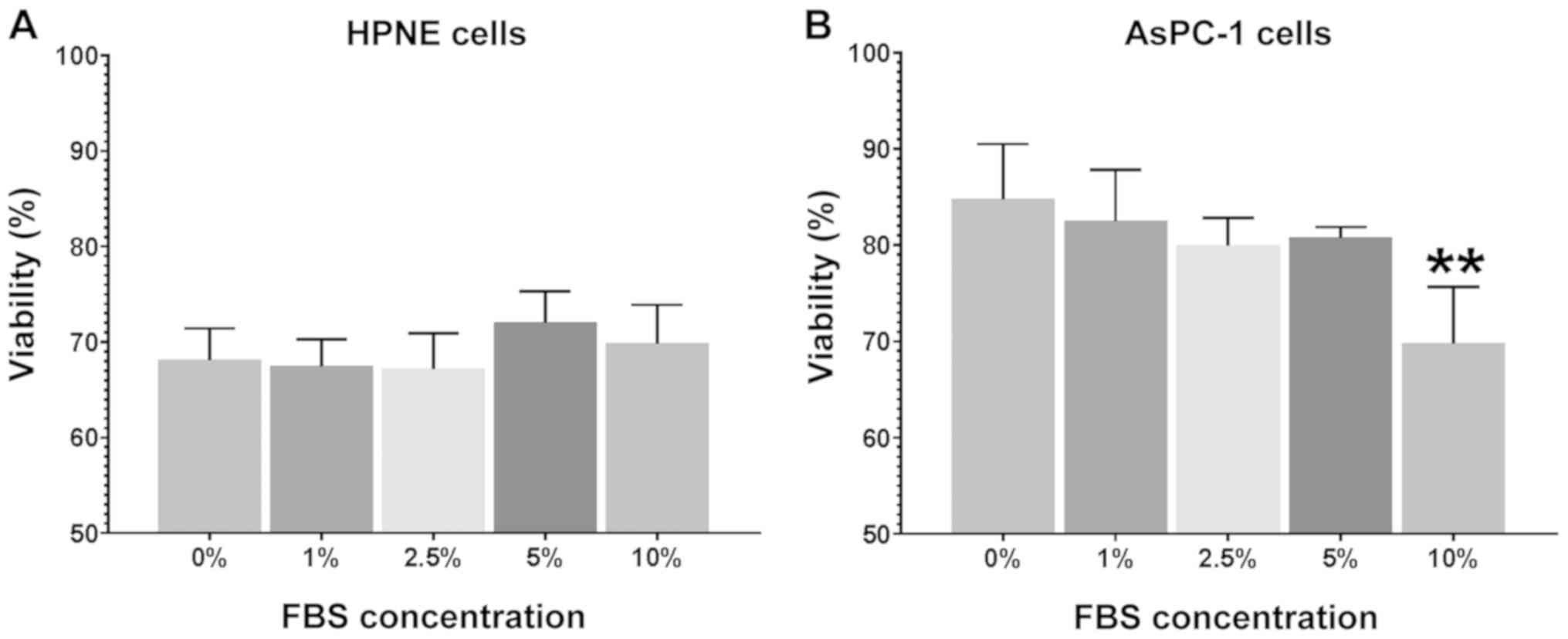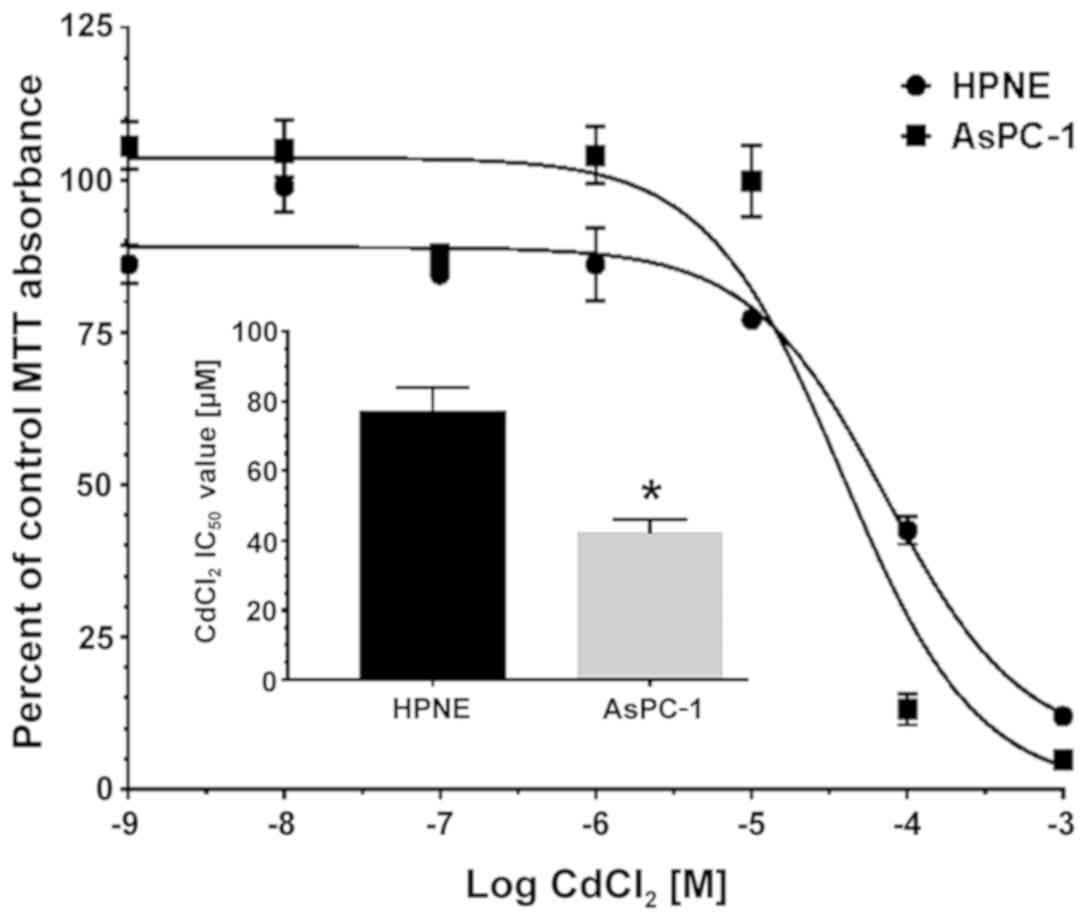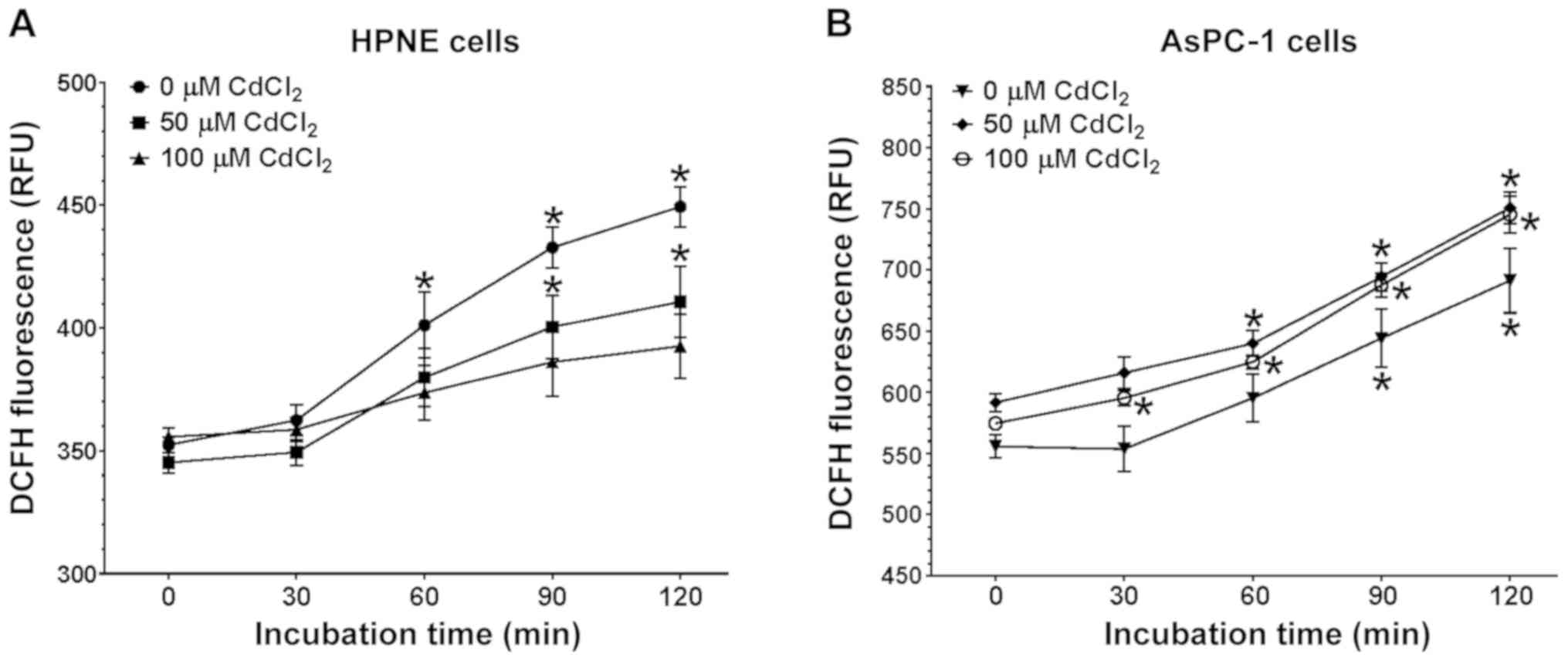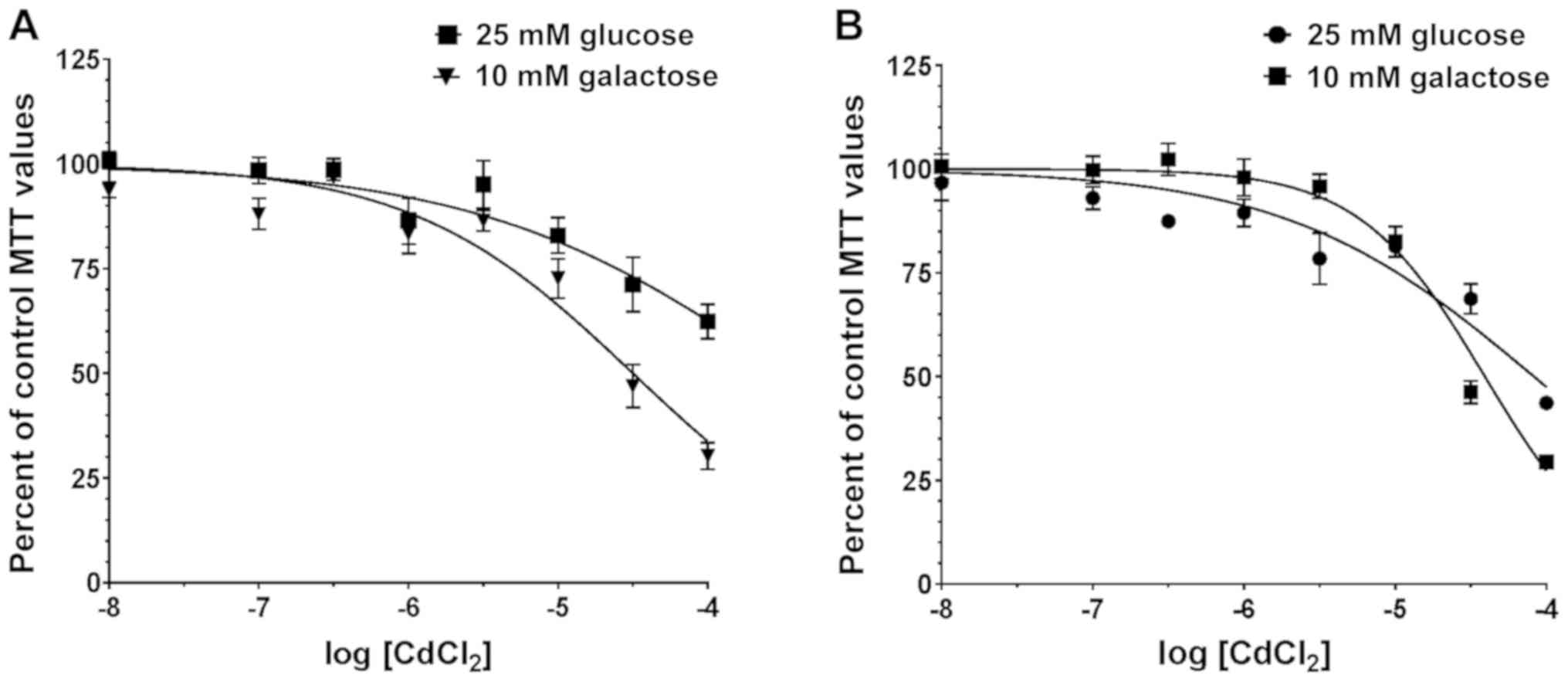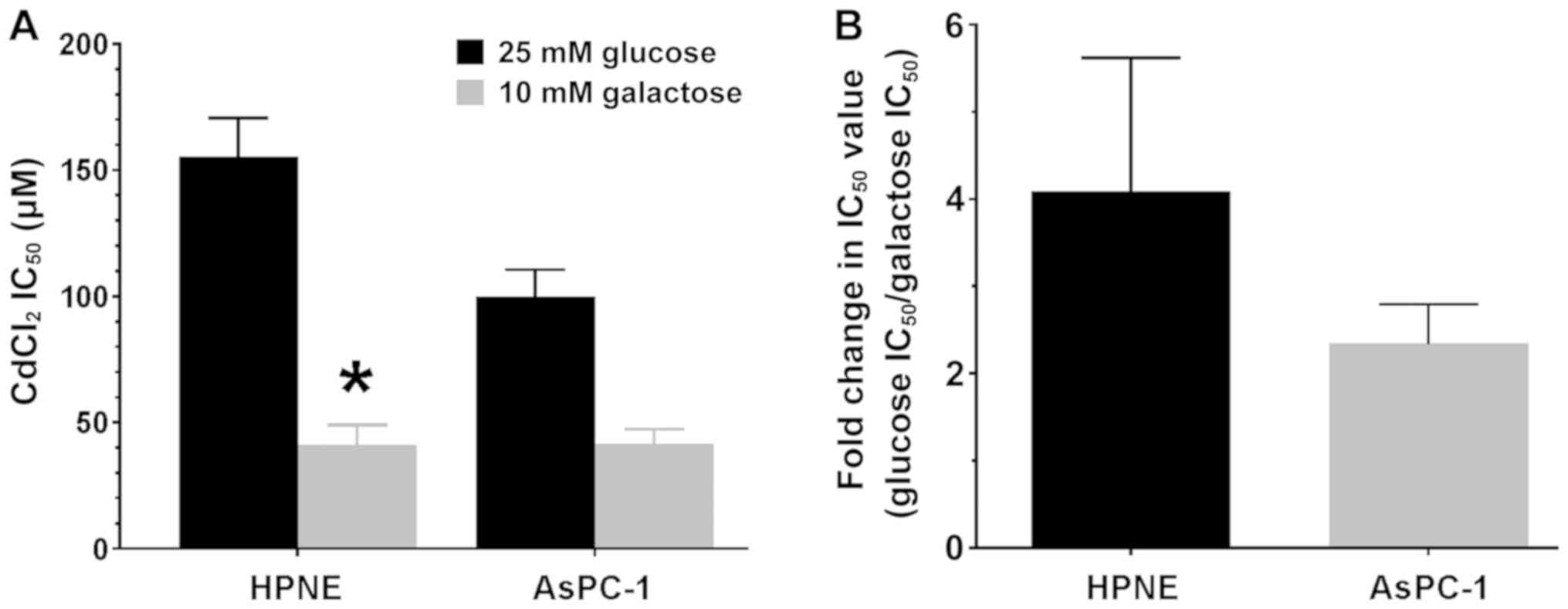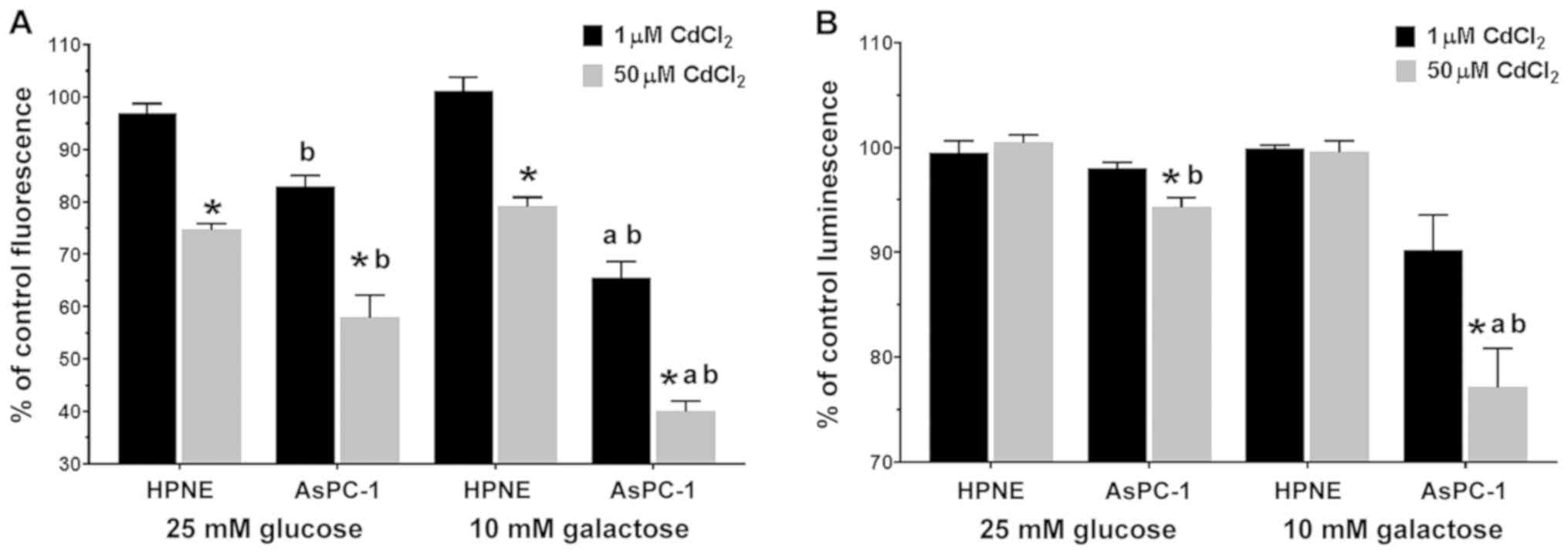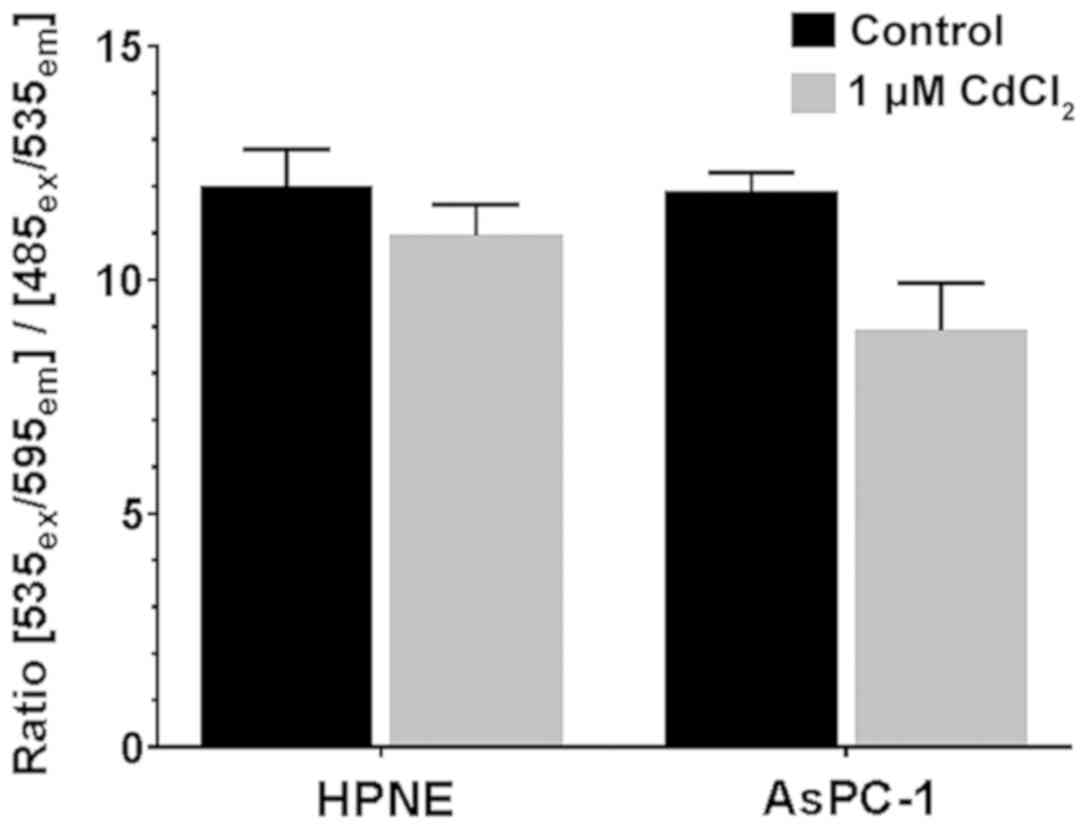|
1
|
Faroon O, Ashizawa A, Wright S, Tucker P,
Jenkins K, Ingerman L and Rudisill C: Toxicological Profile for
Cadmium. Agency for Toxic Substances and Disease Registry. 1–487.
2012.
|
|
2
|
Renieri E, Alegakis A, Kiriakakis M,
Vinceti M, Ozcagli E, Wilks M and Tsatsakis A: Cd, Pb and Hg
Biomonitoring in Fish of the Mediterranean Region and Risk
Estimations on Fish Consumption. Toxics. 2:417–442. 2014.
View Article : Google Scholar
|
|
3
|
Renieri EA, Safenkova IV, Alegakis AK,
Slutskaya ES, Kokaraki V, Kentouri M, Dzantiev BB and Tsatsakis AM:
Cadmium, lead and mercury in muscle tissue of gilthead seabream and
seabass: Risk evaluation for consumers. Food Chem Toxicol.
124:439–449. 2019. View Article : Google Scholar
|
|
4
|
Mezynska M and Brzóska MM: Environmental
exposure to cadmium-a risk for health of the general population in
industrialized countries and preventive strategies. Environ Sci
Pollut Res Int. 25:3211–3232. 2018. View Article : Google Scholar
|
|
5
|
Satarug S: Dietary Cadmium Intake and Its
Effects on Kidneys. Toxics. 6:152018. View Article : Google Scholar :
|
|
6
|
Buha A, Antonijević B, Bulat Z, Jaćević V,
Milovanović V and Matović V: The impact of prolonged cadmium
exposure and co-exposure with polychlorinated biphenyls on thyroid
function in rats. Toxicol Lett. 221:83–90. 2013. View Article : Google Scholar : PubMed/NCBI
|
|
7
|
Buha A, Matovic V, Antonijevic B, Bulat Z,
Curcic M, Renieri EA, Tsatsakis AM, Schweitzer A and Wallace D:
Overview of cadmium thyroid disrupting effects and mechanisms. Int
J Mol Sci. 19:15012018. View Article : Google Scholar :
|
|
8
|
Silva N, Peiris-John R, Wickremasinghe R,
Senanayake H and Sathiakumar N: Cadmium a metalloestrogen: Are we
convinced? J Appl Toxicol. 32:318–332. 2012. View Article : Google Scholar
|
|
9
|
Xing Y, Xia W, Zhang B, Zhou A, Huang Z,
Zhang H, Liu H, Jiang Y, Hu C, Chen X, et al: Relation between
cadmium exposure and gestational diabetes mellitus. Environ Int.
113:300–305. 2018. View Article : Google Scholar : PubMed/NCBI
|
|
10
|
Renieri EA, Sfakianakis DG, Alegakis AA,
Safenkova IV, Buha A, Matović V, Tzardi M, Dzantiev BB, Divanach P,
Kentouri M, et al: Nonlinear responses to waterborne cadmium
exposure in zebrafish. An in vivo study. Environ Res. 157:173–181.
2017. View Article : Google Scholar : PubMed/NCBI
|
|
11
|
IARC: IARC monographs on the evaluation of
the carcinogenic risk of chemicals to man. 1993
|
|
12
|
Iarc and IARC Working Group on the
Evaluation of Carcinogenic Risks to Humans: International Agency
for Research on Cancer Iarc Monographs on the Evaluation of
Carcinogenic Risks to Humans. Personal habits and indoor
combustions. IARC Monogr Eval Carcinog Risks Hum. 100E. 2012
|
|
13
|
Huff J, Lunn RM, Waalkes MP, Tomatis L and
Infante PF: Cadmium-induced cancers in animals and in humans. Int J
Occup Environ Health. 13:202–212. 2007. View Article : Google Scholar : PubMed/NCBI
|
|
14
|
Hartwig A: Cadmium and cancer. Cadmium:
From Toxicity to Essentiality. Sigel A, Sigel H and Sigel RK:
Springer; Netherlands, Dordrecht: pp. 491–507. 2013
|
|
15
|
Il'yasova D and Schwartz GG: Cadmium and
renal cancer. Toxicol Appl Pharmacol. 207:179–186. 2005. View Article : Google Scholar : PubMed/NCBI
|
|
16
|
Vinceti M, Venturelli M, Sighinolfi C,
Trerotoli P, Bonvicini F, Ferrari A, Bianchi G, Serio G, Bergomi M
and Vivoli G: Case-control study of toenail cadmium and prostate
cancer risk in Italy. Sci Total Environ. 373:77–81. 2007.
View Article : Google Scholar
|
|
17
|
Goyer RA, Liu J and Waalkes MP: Cadmium
and cancer of prostate and testis. Biometals. 17:555–558. 2004.
View Article : Google Scholar
|
|
18
|
Feki-Tounsi M and Hamza-Chaffai A: Cadmium
as a possible cause of bladder cancer: A review of accumulated
evidence. Environ Sci Pollut Res Int. 21:10561–10573. 2014.
View Article : Google Scholar : PubMed/NCBI
|
|
19
|
Van Maele-Fabry G, Lombaert N and Lison D:
Dietary exposure to cadmium and risk of breast cancer in
postmenopausal women: A systematic review and meta-analysis.
Environ Int. 86:1–13. 2016. View Article : Google Scholar
|
|
20
|
Cho YA, Kim J, Woo HD and Kang M: Dietary
cadmium intake and the risk of cancer: A meta-analysis. PLoS One.
8:e750872013. View Article : Google Scholar : PubMed/NCBI
|
|
21
|
Bray F, Ferlay J, Soerjomataram I, Siegel
RL, Torre LA and Jemal A: Global cancer statistics 2018: GLOBOCAN
estimates of incidence and mortality worldwide for 36 cancers in
185 countries. CA Cancer J Clin. 68:394–424. 2018. View Article : Google Scholar : PubMed/NCBI
|
|
22
|
Mytilinaiou M, Nikitovic D, Berdiaki A,
Kostouras A, Papoutsidakis A, Tsatsakis AM and Tzanakakis GN:
Emerging roles of syndecan 2 in epithelial and mesenchymal cancer
progression. IUBMB Life. 69:824–833. 2017. View Article : Google Scholar : PubMed/NCBI
|
|
23
|
Tzanakakis GN, Margioris AN, Tsatsakis AM
and Vezeridis MP: The metastatic potential of human pancreatic cell
lines in the liver of nude mice correlates well with cathepsin B
activity. Int J Gastrointest Cancer. 34:27–38. 2003. View Article : Google Scholar
|
|
24
|
Buha A, Wallace D, Matovic V, Schweitzer
A, Oluic B, Micic D and Djordjevic V: Cadmium Exposure as a
Putative Risk Factor for the Development of Pancreatic Cancer:
Three Different Lines of Evidence. BioMed Res Int.
2017:19818372017. View Article : Google Scholar
|
|
25
|
Andjelkovic M, Buha Djordjevic A,
Antonijevic E, Antonijevic B, Stanic M, Kotur-Stevuljevic J,
Spasojevic-Kalimanovska V, Jovanovic M, Boricic N, Wallace D, et
al: Toxic effect of acute cadmium and lead exposure in rat blood,
liver, and kidney. Int J Environ Res Public Health. 16:E2742019.
View Article : Google Scholar : PubMed/NCBI
|
|
26
|
Buha A, Bulat Z, Dukić-Ćosić D and Matović
V: Effects of oral and intraperitoneal magnesium treatment against
cadmium-induced oxidative stress in plasma of rats. Arh Hig Rada
Toksikol. 63:247–254. 2012. View Article : Google Scholar : PubMed/NCBI
|
|
27
|
Matović V, Buha A, Bulat Z, Ðukić-Ćosić D,
Miljković M, Ivanišević J and Kotur-Stevuljević J: Route-dependent
effects of cadmium/cadmium and magnesium acute treatment on
parameters of oxidative stress in rat liver. Food Chem Toxicol.
50:552–557. 2012. View Article : Google Scholar
|
|
28
|
Djukić-Cosić D, Curcić Jovanović M,
Plamenac Bulat Z, Ninković M, Malicević Z and Matović V: Relation
between lipid peroxidation and iron concentration in mouse liver
after acute and subacute cadmium intoxication. J Trace Elem Med
Biol. 22:66–72. 2008. View Article : Google Scholar
|
|
29
|
Bulat Z, Dukić-Osi-Ćosić D, Antonijević B,
Bulat P, Vujanović D, Buha A and Matović V: Effect of magnesium
supplementation on the distribution patterns of zinc, copper, and
magnesium in rabbits exposed to prolonged cadmium intoxication. Sci
World J. 2012:2012. View Article : Google Scholar
|
|
30
|
Djukić-Cosić D, Ninković M, Malicević Z,
Plamenac-Bulat Z and Matović V: Effect of supplemental magnesium on
the kidney levels of cadmium, zinc, and copper of mice exposed to
toxic levels of cadmium. Biol Trace Elem Res. 114:281–291. 2006.
View Article : Google Scholar
|
|
31
|
Matović V, Buha A, Ðukić-Ćosić D and Bulat
Z: Insight into the oxidative stress induced by lead and/or cadmium
in blood, liver and kidneys. Food Chem Toxicol. 78:130–140. 2015.
View Article : Google Scholar
|
|
32
|
Bulat Z, Đukić-Ćosić D, Antonijević B,
Buha A, Bulat P, Pavlović Z and Matović V: Can zinc supplementation
ameliorate cadmium-induced alterations in the bioelement content in
rabbits? Arh Hig Rada Toksikol. 68:38–45. 2017. View Article : Google Scholar : PubMed/NCBI
|
|
33
|
Zhang DX, Dai YD, Yuan SX and Tao L:
Prognostic factors in patients with pancreatic cancer. Exp Ther
Med. 3:423–432. 2012. View Article : Google Scholar : PubMed/NCBI
|
|
34
|
Liu J, Ji S, Liang C, Qin Y, Jin K, Liang
D, Xu W, Shi S, Zhang B, Liu L, et al: Critical role of oncogenic
KRAS in pancreatic cancer (Review). Mol Med Rep. 13:4943–4949.
2016. View Article : Google Scholar : PubMed/NCBI
|
|
35
|
Basu A, Jiang X, Negrini M and Haldar S:
MicroRNA-mediated regulation of pancreatic cancer cell
proliferation. Oncol Lett. 1:565–568. 2010. View Article : Google Scholar : PubMed/NCBI
|
|
36
|
Duarte FV, Palmeira CM and Rolo AP: The
role of microRNAs in mitochondria: Small players acting wide. Genes
(Basel). 5:865–886. 2014. View Article : Google Scholar
|
|
37
|
Cannino G, Ferruggia E, Luparello C and
Rinaldi AM: Cadmium and mitochondria. Mitochondrion. 9:377–384.
2009. View Article : Google Scholar : PubMed/NCBI
|
|
38
|
Li M, Xia T, Jiang CS, Li LJ, Fu JL and
Zhou ZC: Cadmium directly induced the opening of membrane
permeability pore of mitochondria which possibly involved in
cadmium-triggered apoptosis. Toxicology. 194:19–33. 2003.
View Article : Google Scholar : PubMed/NCBI
|
|
39
|
Mao WP, Zhang NN, Zhou FY, Li WX, Liu HY,
Feng J, Zhou L, Wei CJ, Pan YB and He ZJ: Cadmium directly induced
mitochondrial dysfunction of human embryonic kidney cells. Hum Exp
Toxicol. 30:920–929. 2011. View Article : Google Scholar
|
|
40
|
Gobe G and Crane D: Mitochondria, reactive
oxygen species and cadmium toxicity in the kidney. Toxicol Lett.
198:49–55. 2010. View Article : Google Scholar : PubMed/NCBI
|
|
41
|
Lasfer M, Vadrot N, Aoudjehane L, Conti F,
Bringuier AF, Feldmann G and Reyl-Desmars F: Cadmium induces
mitochondria-dependent apoptosis of normal human hepatocytes. Cell
Biol Toxicol. 24:55–62. 2008. View Article : Google Scholar
|
|
42
|
Chang KC, Hsu CC, Liu SH, Su CC, Yen CC,
Lee MJ, Chen KL, Ho TJ, Hung DZ, Wu CC, et al: Cadmium induces
apoptosis in pancreatic β-cells through a mitochondria-dependent
pathway: The role of oxidative stress-mediated c-Jun N-terminal
kinase activation. PLoS One. 8:e543742013. View Article : Google Scholar
|
|
43
|
Tinkov AA, Filippini T, Ajsuvakova OP,
Aaseth J, Gluhcheva YG, Ivanova JM, Bjørklund G, Skalnaya MG,
Gatiatulina ER, Popova EV, et al: The role of cadmium in obesity
and diabetes. Sci Total Environ. 601-602:741–755. 2017. View Article : Google Scholar : PubMed/NCBI
|
|
44
|
Hammad N, Rosas-Lemus M, Uribe-Carvajal S,
Rigoulet M and Devin A: The Crabtree and Warburg effects: Do
metabolite-induced regulations participate in their induction?
Biochim Biophys Acta. 1857:1139–1146. 2016. View Article : Google Scholar : PubMed/NCBI
|
|
45
|
Diaz-Ruiz R, Rigoulet M and Devin A: The
Warburg and Crabtree effects: On the origin of cancer cell energy
metabolism and of yeast glucose repression. Biochim Biophys Acta.
1807:568–576. 2011. View Article : Google Scholar
|
|
46
|
Devic S: Warburg effect - a consequence or
the cause of carcinogenesis? J Cancer. 7:817–822. 2016. View Article : Google Scholar : PubMed/NCBI
|
|
47
|
de Alteriis E, Cartenì F, Parascandola P,
Serpa J and Mazzoleni S: Revisiting the Crabtree/Warburg effect in
a dynamic perspective: A fitness advantage against sugar-induced
cell death. Cell Cycle. 17:688–701. 2018. View Article : Google Scholar : PubMed/NCBI
|
|
48
|
Solaini G, Sgarbi G and Baracca A:
Oxidative phosphorylation in cancer cells. Biochim Biophys Acta.
1807:534–542. 2011. View Article : Google Scholar
|
|
49
|
Chandra D and Singh KK: Genetic insights
into OXPHOS defect and its role in cancer. Biochim Biophys Acta.
1807:620–625. 2011. View Article : Google Scholar
|
|
50
|
Mot AI, Liddell JR, White AR and Crouch
PJ: Circumventing the Crabtree Effect: A method to induce lactate
consumption and increase oxidative phosphorylation in cell culture.
Int J Biochem Cell Biol. 79:128–138. 2016. View Article : Google Scholar : PubMed/NCBI
|
|
51
|
Lamas-Maceiras M, Rodríguez-Belmonte E,
Becerra M, González-Siso MI and Cerdán ME: KlGcr1 controls
glucose-6-phosphate dehydrogenase activity and responses to H O
cadmium and arsenate in Kluyveromyces lactis. Fungal Genet 2 2,
Biol. 82:95–103. 2015. View Article : Google Scholar
|
|
52
|
Torres AM, Maceiras ML, Belmonte ER,
Naveira LN, Calvo MB and Cerdán ME: KlRox1 pcontributes to yeast
resistance to metals and is necessary for KlYCF1 expression in the
presence of cadmium. Gene. 497:27–37. 2012. View Article : Google Scholar : PubMed/NCBI
|
|
53
|
Djordjevic VR, Wallace DR, Schweitzer A,
Boricic N, Knezevic D, Matic S, Grubor N, Kerkez M, Radenkovic D,
Bulat Z, et al: Environmental cadmium exposure and pancreatic
cancer: Evidence from case control, animal and in vitro studies.
Environ Int. 128:353–361. 2019. View Article : Google Scholar : PubMed/NCBI
|
|
54
|
Wallace DR and Bates E: Differential
effects of organic and inorganic mercury on phenotypically variant
breast cancer cell lines. J Clin Toxicol. 5:10002732015. View Article : Google Scholar
|
|
55
|
Sanuki Y, Araki T, Nakazono O and Tsurui
K: A rapid mitochondrial toxicity assay utilizing rapidly changing
cell energy metabolism. J Toxicol Sci. 42:349–358. 2017. View Article : Google Scholar : PubMed/NCBI
|
|
56
|
Dott W, Mistry P, Wright J, Cain K and
Herbert KE: Modulation of mitochondrial bioenergetics in a skeletal
muscle cell line model of mitochondrial toxicity. Redox Biol.
2:224–233. 2014. View Article : Google Scholar : PubMed/NCBI
|
|
57
|
Niles AL, Moravec RA, Eric Hesselberth P,
Scurria MA, Daily WJ and Riss TL: A homogeneous assay to measure
live and dead cells in the same sample by detecting different
protease markers. Anal Biochem. 366:197–206. 2007. View Article : Google Scholar : PubMed/NCBI
|
|
58
|
Marroquin LD, Hynes J, Dykens JA, Jamieson
JD and Will Y: Circumventing the Crabtree effect: Replacing media
glucose with galactose increases susceptibility of HepG2 cells to
mitochondrial toxicants. Toxicol Sci. 97:539–547. 2007. View Article : Google Scholar : PubMed/NCBI
|
|
59
|
Rossignol R, Gilkerson R, Aggeler R,
Yamagata K, Remington SJ and Capaldi RA: Energy substrate modulates
mitochondrial structure and oxidative capacity in cancer cells.
Cancer Res. 64:985–993. 2004. View Article : Google Scholar : PubMed/NCBI
|
|
60
|
Rodríguez-Enríquez S, Juárez O,
Rodríguez-Zavala JS and Moreno-Sánchez R: Multisite control of the
Crabtree effect in ascites hepatoma cells. Eur J Biochem.
268:2512–2519. 2001. View Article : Google Scholar : PubMed/NCBI
|
|
61
|
Taverna M, Marie AL, Mira JP and Guidet B:
Specific antioxidant properties of human serum albumin. Ann
Intensive Care. 3:42013. View Article : Google Scholar : PubMed/NCBI
|
|
62
|
Hsiao IL and Huang YJ: Effects of serum on
cytotoxicity of nano- and micro-sized ZnO particles. J Nanopart
Res. 15:18292013. View Article : Google Scholar : PubMed/NCBI
|
|
63
|
Leelakanok N, Fischer CL, Bates AM,
Guthmiller JM, Johnson GK, Salem AK, Brogden KA and Brogden NK:
Cytotoxicity of HBD3 for dendritic cells, normal human epidermal
keratinocytes, hTERT keratinocytes, and primary oral gingival
epithelial keratinocytes in cell culture conditions. Toxicol Lett.
239:90–96. 2015. View Article : Google Scholar : PubMed/NCBI
|
|
64
|
Umebayashi C, Oyama Y, Chikahisa-Muramastu
L, Nakao H, Nishizaki Y, Nakata M, Soeda F and Takahama K:
Tri-n-butyltin-induced cytotoxicity on rat thymocytes in presence
and absence of serum. Toxicol In Vitro. 18:55–61. 2004. View Article : Google Scholar
|
|
65
|
Qiao D, Seidler FJ and Slotkin TA:
Developmental neurotoxicity of chlorpyrifos modeled in vitro:
Comparative effects of metabolites and other cholinesterase
inhibitors on DNA synthesis in PC12 and C6 cells. Environ Health
Perspect. 109:909–913. 2001. View Article : Google Scholar : PubMed/NCBI
|
|
66
|
Stohs SJJ and Bagchi D: Oxidative
mechanisms in the toxicity of metal ions. Free Radic Biol Med.
18:321–336. 1995. View Article : Google Scholar : PubMed/NCBI
|
|
67
|
Ercal N, Gurer-Orhan H and Aykin-Burns N:
Toxic metals and oxidative stress part I: Mechanisms involved in
metal-induced oxidative damage. Curr Top Med Chem. 1:529–539. 2001.
View Article : Google Scholar
|
|
68
|
Valko M, Rhodes CJ, Moncol J, Izakovic M
and Mazur M: Free radicals, metals and antioxidants in oxidative
stress-induced cancer. Chem Biol Interact. 160:1–40. 2006.
View Article : Google Scholar : PubMed/NCBI
|
|
69
|
Galaris D and Evangelou A: The role of
oxidative stress in mechanisms of metal-induced carcinogenesis.
Crit Rev Oncol Hematol. 42:93–103. 2002. View Article : Google Scholar : PubMed/NCBI
|
|
70
|
Thomas MG, Marwood RM, Parsons AE and
Parsons RB: The effect of foetal bovine serum supplementation upon
the lactate dehydrogenase cytotoxicity assay: Important
considerations for in vitro toxicity analysis. Toxicol In Vitro.
30:300–308. 2015. View Article : Google Scholar : PubMed/NCBI
|
|
71
|
Cadm ium toxicity and treatment.
ScientificWorldJournal. 2013:3946522013.
|
|
72
|
Franco R, Sánchez-Olea R, Reyes-Reyes EM
and Panayiotidis MI: Environmental toxicity, oxidative stress and
apoptosis: Ménage à trois. Mutat Res. 674:3–22. 2009. View Article : Google Scholar
|
|
73
|
Chen C, Xun P, Nishijo M, Sekikawa A and
He K: Cadmium exposure and risk of pancreatic cancer: A
meta-analysis of prospective cohort studies and case-control
studies among individuals without occupational exposure history.
Environ Sci Pollut Res Int. 22:17465–17474. 2015. View Article : Google Scholar : PubMed/NCBI
|
|
74
|
Chen P, Duan X, Li M, Huang C, Li J, Chu
R, Ying H, Song H, Jia X, Ba Q, et al: Systematic network
assessment of the carcinogenic activities of cadmium. Toxicol Appl
Pharmacol. 310:150–158. 2016. View Article : Google Scholar : PubMed/NCBI
|
|
75
|
Waalkes MP: Cadmium carcinogenesis. Mutat
Res. 533:107–120. 2003. View Article : Google Scholar : PubMed/NCBI
|
|
76
|
WHO: Exposure to Cadmium: A Major Public
Health Concern. Geneva. 2010.
|
|
77
|
Muthukumaravel K, Kumarasamy P, Amsath A
and Paulraj MG: Toxic effect of cadmium on the electrophoretic
protein patterns of gill and muscle of Oreochromis mossambicus. E-J
Chem. 4:284–286. 2007. View Article : Google Scholar
|
|
78
|
Fotakis G and Timbrell JA: In vitro
cytotoxicity assays: Comparison of LDH, neutral red, MTT and
protein assay in hepatoma cell lines following exposure to cadmium
chloride. Toxicol Lett. 160:171–177. 2006. View Article : Google Scholar
|
|
79
|
Hinkle PM, Kinsella PA and Osterhoudt KC:
Cadmium uptake and toxicity via voltage-sensitive calcium channels.
J Biol Chem. 262:16333–16337. 1987.PubMed/NCBI
|
|
80
|
Bertin G and Averbeck D: Cadmium: Cellular
effects, modifications of biomolecules, modulation of DNA repair
and genotoxic consequences (a review). Biochimie. 88:1549–1559.
2006. View Article : Google Scholar : PubMed/NCBI
|
|
81
|
Cuypers A, Plusquin M, Remans T, Jozefczak
M, Keunen E, Gielen H, Opdenakker K, Nair AR, Munters E, Artois TJ,
et al: Cadmium stress: An oxidative challenge. Biometals.
23:927–940. 2010. View Article : Google Scholar : PubMed/NCBI
|
|
82
|
Tzanakakis GN, Krambovitis E, Tsatsakis AM
and Vezeridis MP: The preventive effect of ketoconazole on
experimental metastasis from a human pancreatic carcinoma may be
related to its effect on prostaglandin synthesis. Int J
Gastrointest Cancer. 32:23–30. 2002. View Article : Google Scholar
|















